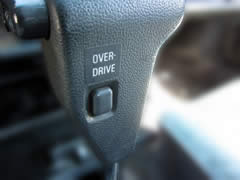What Is O/D (Over Drive) Button On My Shift Knob? - Vol.207
Have you seen the button located on your shift knob but have no idea what it is or what it does? That button is known as the overdrive (O/D) and regulates the gear system of your automatic vehicle. You might be wondering why such an option exists; you bought an automatic vehicle so that you didn't have to deal with this type of mechanical jargon, right? Despite the convenience of an automatic vehicle, a little manual work of using the O/D does have a useful purpose and will benefit you financially to learn what it does and how to use it.

So, What Does it Do?
The short answer to what the O/D does is that it saves you money on gas. When the O/D is on, your transmission lowers the revolutions per minute (RPMs) of the engine to make it work less to achieve the same job. You'll notice that if you drive 10 miles going up hill, your vehicle is forced to put in a lot of effort. As a result your gas will be eaten up a lot faster than if you were driving on a flat road for the same 10 miles. Less work equals better fuel economy.
You may be wondering why your car has this option but some of your friend's cars do not. Many of the newer vehicles being produced are no longer being built with these overdrive buttons, but they do still have these features installed; instead newer vehicles automatically turn on the overdrive usually when the speed exceeds 45 miles per hour. Just because your vehicle has a physical button doesn't mean that it is difficult or complex to use, most of the time it's as simple as turning on the radio.
How Do I Turn O/D On?
The primary setting on your automatic vehicle is to use this function whenever possible; therefore, pressing the overdrive button will actually turn the cars' overdrive function off. It is recommended that whenever you are driving your vehicle that you leave the overdrive on. Whenever overdrive is on, you are saving money on gasoline because your car is being more efficient and doing more with less.
If It Saves Me Money, Why Would I Turn it Off?
Vehicle manufactures include this O/D function for the purpose of towing and climbing hills. When your vehicle is taking part in a strenuous activity, you want to utilize the full power of your vehicle by increasing its torque. Increasing the torque and allowing your vehicle to operate with its full potential will decrease the damage that could be caused on your vehicle from towing and generating heat.
What Are RPMs and Torque and How Does O/D Affect These?
Revolutions per minute, or the RPMs, are the total 360o rotations that an engine crankshaft can perform within 60 seconds. You've probably seen the RPM meter on your dashboard; this meter can be detected by a portion of the meter shaded in red. The red color indicated what is essentially the "danger zone," or a level that you should not go above without shifting into a higher gear. The higher the RPMs, the harder your car is working to perform the speed and power that you desire. O/D is a little bit like a manual regulator telling your car to take it easy.
The total power of your?or horsepower?is the amount that your car is able to accomplish in a certain amount of time. Horsepower can be calculated by multiplying your total RPMs and the torque of the vehicle. If your vehicle is running in overdrive, the RPMs will be lower, and therefore the vehicle will have less power. When this O/D option is disengaged the power of the vehicle will increase. That means that whenever you are in need of an extra boost, turn your overdrive off, but otherwise do your best to leave it alone.